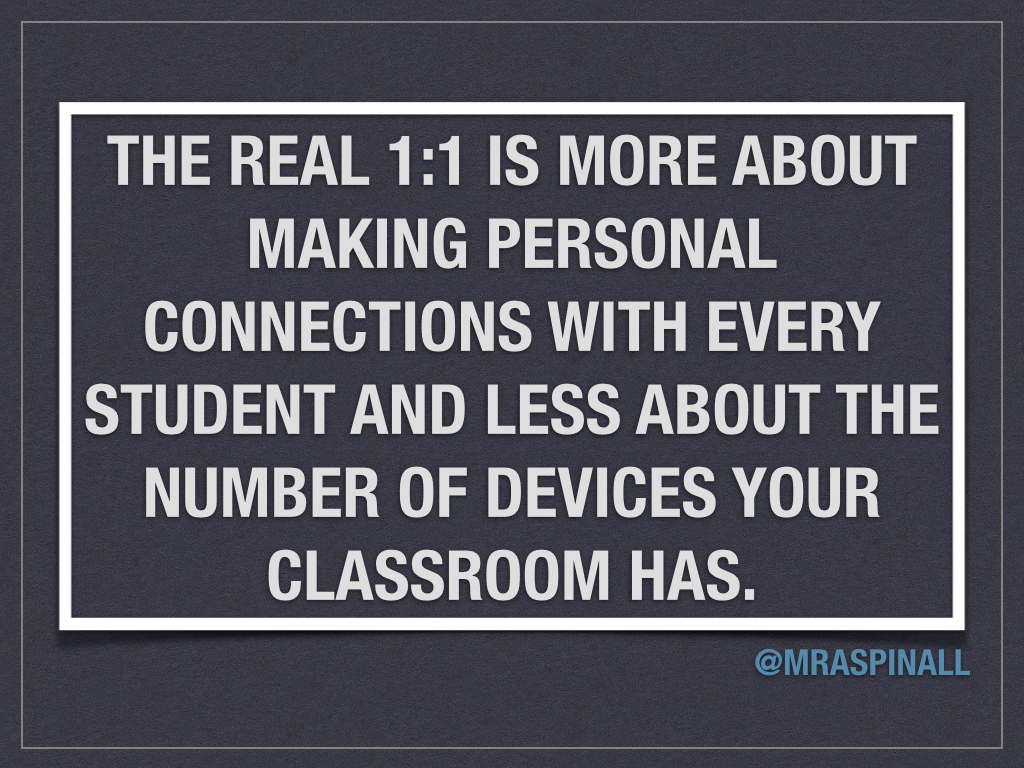Full disclosure: Much of this post comes from conversations with my administrator Chris Moore (@icprin). I would like to acknowledge him before you continue reading.
The more and more I think about changing my classroom practices, the less and less I consider technology. Perhaps I should celebrate how embedded in practice it has become since I no longer consider it an event. It takes times for this natural fit. Time and energy.
Two things teachers don’t have much of during the week – time and energy. Between raising families, coaching sports teams, planning lessons and marking at night (forget having a social life), it can be challenging to learn about new tools an technologies. Trying a new app with a full class of kids generates a lot of anxiety and fear. What happens if the technology fails?
I am starting to wonder if these are excuses. “If we worked in industry and didn’t keep up with best practices we would be fired.” via @icprin. That’s a scary thought.
However, more so than focusing on technology – whether it is an event or not – we should consider changing pedagogies. How do you plan to implement something like Genius Hour if you are still off and away? Is giving every kid an iDevice and telling them to all complete the same task anything different than not using the iDevice at all? Using “AppName” for the sake of using the app seems backwards. Green screens are fun, but what are we truly learning in the process? Let’s talk about that in class instead of who made the coolest video.
While there is no app for great teaching, the proper implementation of technology has the power to make all kids successful. Yes – all! But making all kids successful puts a tremendous accountability on them to want to learn. This process takes time. We need to move away from structured charts and rubrics that seem to baby step kids through tasks and focus on big ideas, inquiry and student passions. Sure, many kids need the scaffolding, but the one size fits all model of schooling is no longer acceptable. If our goal is to truly personalize learning, differentiate instruction and scaffold lessons, every students’ program is unique. Technology allows this to happen, but it won’t happen overnight and this throws a giant monkey wrench into current methods of assessment and evaluation where there is a grade level standard. What about those kids above grade level? They need as much attention as those “below” grade level “standards”.
Since “school” began, we have always focused on student weaknesses and next steps. “Little Johnny excels in math but needs help reading so lets focus on that.” I highly doubt little Johnny is going to pursue a career in reading. Don’t get me wrong, I am not suggesting we ignore the gaps in little Johnny’s learning, I’m just suggesting that we have tools and technologies to assist little Johnny with his reading – now can he go change the world in math? There is a reason I studied Computer Science at University and it wasn’t because I loved to read and write.
I encourage you to read the article below. If we acknowledge the one size model does not work, why do we use it to “test” students for some level of brilliance? Sometimes kids are just really good test takers. Besides, these enrichment programs are nothing more than STEM – which happens in many classrooms nowadays with makerspace, coding, etc.
Shouldn’t All Students Be Able to Participate in Gifted Programs?
Changing the mindsets and culture takes a tremendous amount of time. And it shouldn’t start in classrooms. If we want to make significant impacts on education paradigms, new pedagogies must begin in the office with administration. Education 2.0 is about student voice and choice.
Why else do Google employees socialize at work? They have daycare facilities, built in restaurants, social clubs, etc. because Google never wants their employees to want to leave.
There has been a strong quote floating around the edu-twittersphere. I will do my best to paraphrase it:
Would you want to be a student in your class?
While I admire the quote and the origin of it, I don’t think it is enough. Instead ask yourself:




 For all the kids who grow up in a small town and think they don’t stand a chance. You do. I was once that kid.
For all the kids who grow up in a small town and think they don’t stand a chance. You do. I was once that kid.
Brian:
Having read Dr Green’s article on gifted programming, and read the comments to go with it, I feel like we need to make a differentiation. Pull-out gifted programs, where students get an occasional chance to work on an engaging project (often hands-on science), is the kind of programming that every student should have access to, yes. Differentiating that from a congregated class for gifted learners, which may span a variety of age ranges and work to meet the sometimes complex social/emotional needs of a diverse group of gifted learners, is important. Different boards offer different things, and, as a parent of two kids identified as gifted, I think it’s important that we don’t just lump “gifted programs” into a box meaning getting to go play with the robots.
Yes, all kids should have access to exciting, engaging learning opportunities in their classrooms. No, that’s not the definition of gifted learning spaces. 🙂
Thanks for the great distinction between gifted opportunities and gifted classes. They are definitely two different aspects.
I guess my questions become:
What defines students as “gifted” and what are gifted learning spaces?
What about the other end of the “spectrum”?